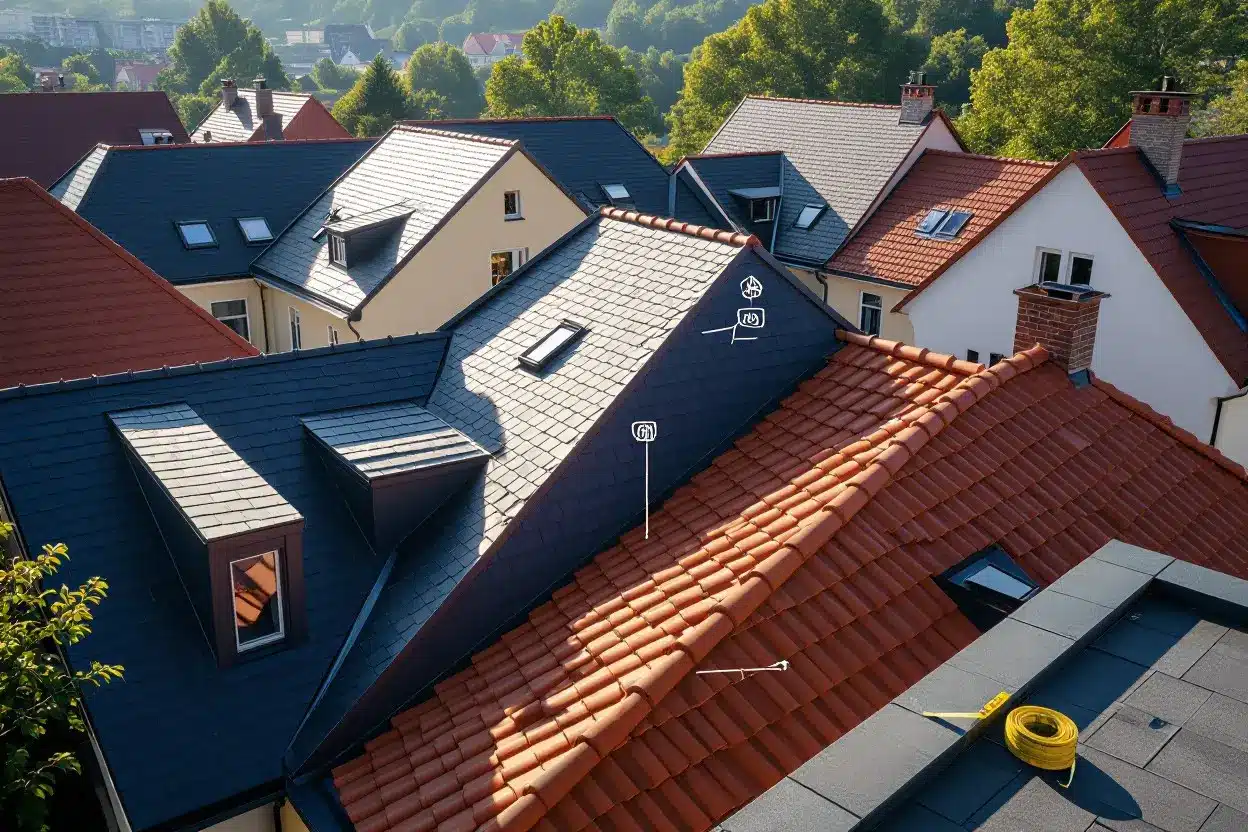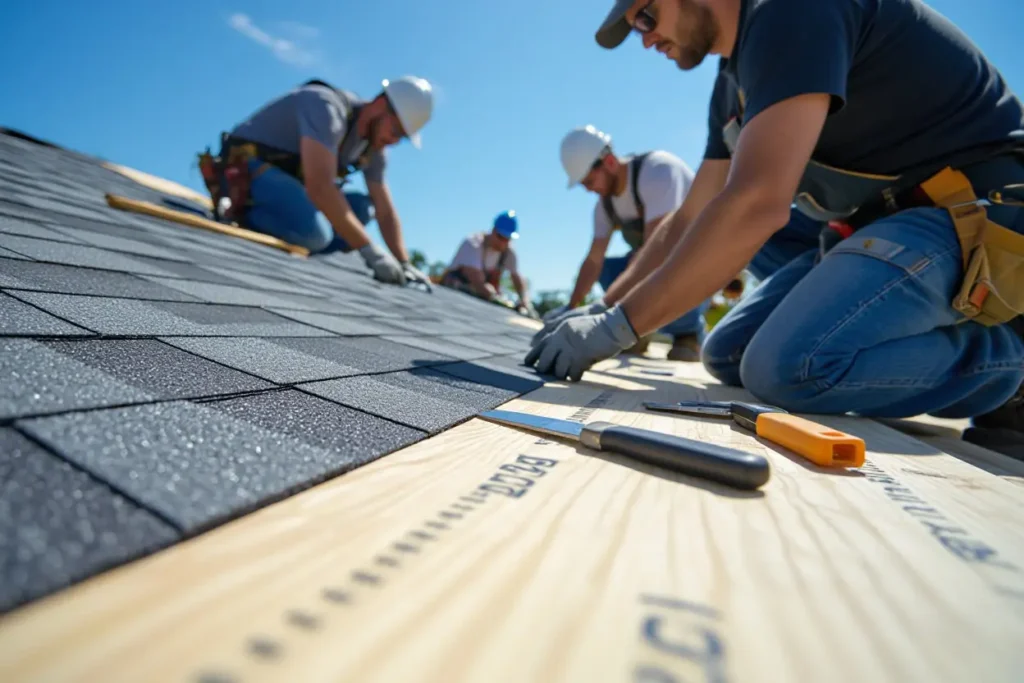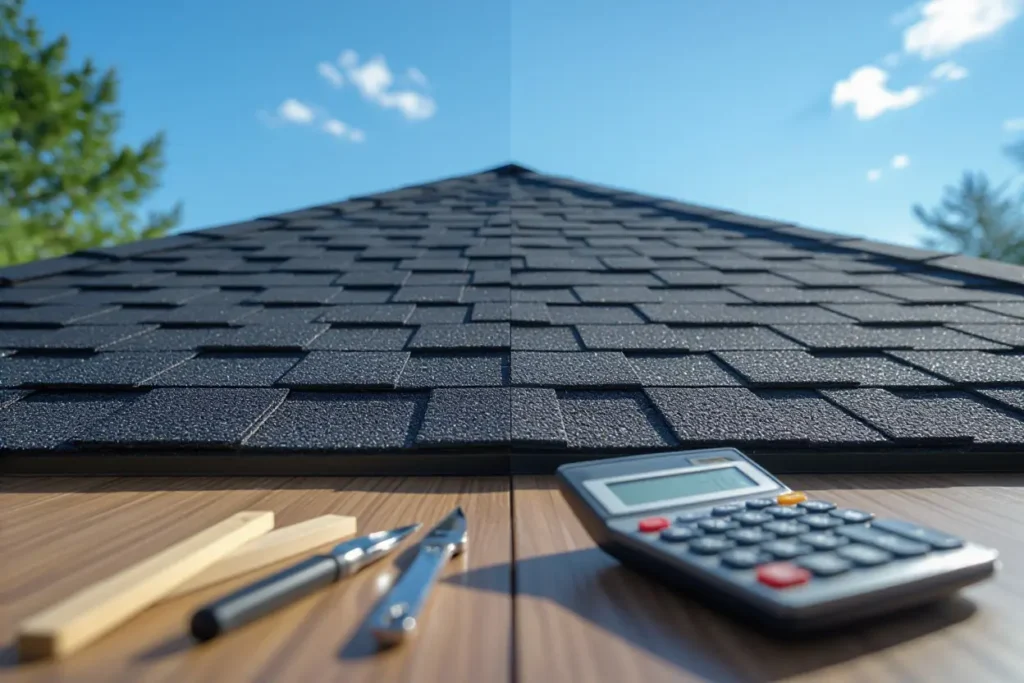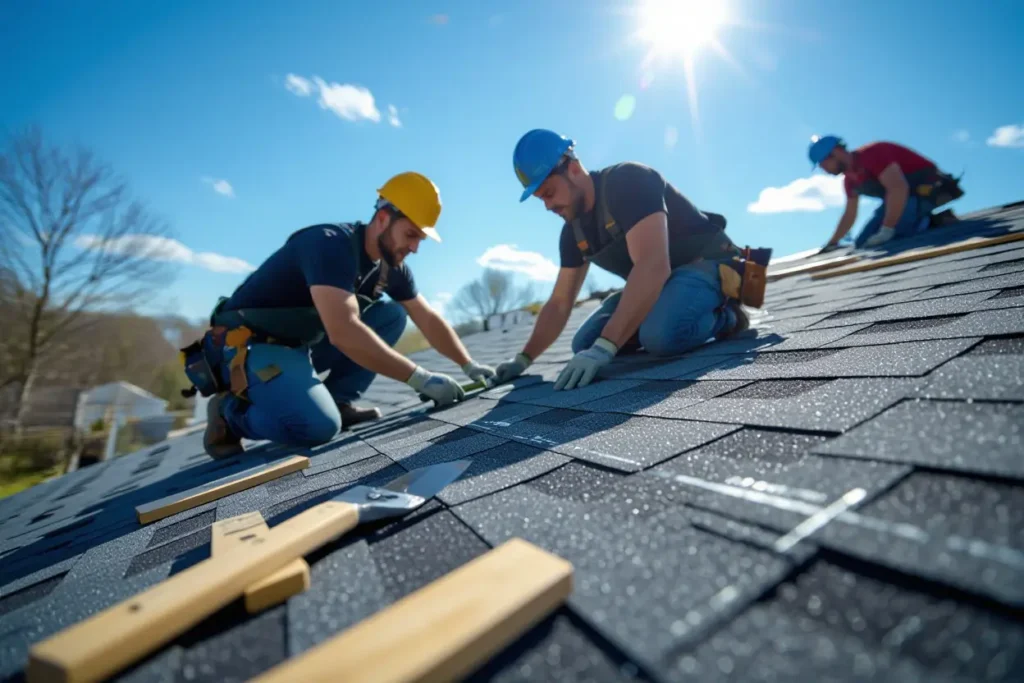Understanding Pitch Roofing – Key Benefits Explained

The weather in Winnipeg is no joke, and a sturdy roof is essential for protecting your home. When it comes to long-lasting performance, pitch roofing is an excellent option to consider. It’s designed to withstand the harsh realities of our climate, from heavy snowfall to powerful winds.
This guide from All Weather Exteriors, a leading Winnipeg roofing company, will walk you through the key benefits of pitch roofing. We’ll explain how it improves drainage, increases durability, and even helps boost your home’s energy efficiency. We’ll also dive into how proper insulation, smart material choices, and the right roof angle can work together to lower your heating costs, simplify maintenance, and give your home a beautiful, lasting aesthetic.
Key Takeaways:
- Pitched roofs shed snow and rain efficiently — their slope reduces standing water and ice dams, making them well-suited for Winnipeg’s heavy snowfall and freeze-thaw cycles.
- When combined with proper insulation, pitched roofing cuts heating and cooling costs — homeowners typically see roughly 15–30% lower energy use, which matters in Manitoba’s cold winters.
- Durable materials (slate, tile, metal) and professional installation extend roof life and lower maintenance needs — All Weather Exteriors, Winnipeg’s #1 roofing company, can help select and install options built to last.
Structural Advantages of Pitch Roofing
Natural Water Management Through Slope
Your roof’s slope is the first line of defense against standing water and ice formation. Pitches as low as 3:12 provide reliable drainage, while common residential pitches in Winnipeg often range from 6:12 to steeper profiles to cope with heavy snowfall and rapid melt events. With over 100 cm of average annual snowfall in the region and frequent freeze–thaw cycles, a proper slope helps shed snow quickly and reduces the formation of ice dams that force water under shingles and into the attic.
Design details further improve performance: continuous eavestroughs sized for higher runoff, correctly installed valley flashing, and an ice-and-water shield in vulnerable eave zones all work together with the pitch to channel moisture away from your structure. Adequate attic ventilation paired with insulation reduces warm spots that cause uneven melting, so you’ll see fewer moisture issues in roof assemblies and adjacent living spaces over the long term.
Enhanced Durability Against Environmental Stressors
Sloped roofs inherently resist many environmental stressors that plague flat systems. The geometry reduces the surface area exposed to wind uplift and minimizes the chance of debris impact lingering on the roof. Durable materials commonly used on pitched roofs — such as metal panels, architectural asphalt shingles, and clay or concrete tiles — offer proven lifespans: architectural shingles typically 20–30 years, many metal systems 40–70 years, and high-quality slate or tile often exceeding 50 years when properly maintained.
Cold Winnipeg winters and intense summer sun put roofing materials through wide thermal swings; pitched systems mitigate these effects by encouraging snow to slide off and avoiding prolonged water contact that accelerates freeze–thaw damage. Properly detailed underlayment, flashing around penetrations, and a breathable air barrier will prevent condensation and rot in roof sheathing and rafters, protecting the structural deck beneath your chosen finish.
Lower maintenance frequency is a practical benefit you’ll notice: fewer emergency repairs after storms and reduced risk of costly interior water damage. Many homeowners in the area find that choosing the right pitch and robust materials pays back through longer service intervals and a reduced total cost of ownership, aligning with the long-term value metrics often used in local roofing case studies.

Energy Efficiency: The Economic Advantage
Lower energy bills translate directly into better long-term returns on your roofing investment. Properly designed pitched roofs let you combine high-performance insulation and improved ventilation to cut drafty heat loss in winter and reduce cooling demand in summer. Typical results for Winnipeg homeowners show annual energy savings in the 15–30% range after upgrading roof insulation and sealing attic air leaks; on a household spending roughly $2,500 a year for heating and cooling, that can mean $375–$750 saved each year. Those savings add up quickly and shorten the payback period on your upfront roofing or retrofit costs.
Beyond the immediate utility reductions, pitched roofs with upgraded assemblies often deliver an attractive mid-term ROI. Case studies in similar cold climates report return on investment between 50% and 75% within the first decade, driven by lower fuel use, reduced HVAC cycling, and fewer moisture-related repairs. You can also expect extended equipment life for furnaces and air conditioners because your systems run less often and under less strain.
The Impact of Insulation in Pitched Roofs
Choosing the right insulation type and target R-value matters for Winnipeg’s long winters. Closed-cell spray foam provides roughly R-6 to R-7 per inch and acts as an effective air and vapor barrier, while rigid polyiso board gives about R-5.5–R-6.5 per inch and works well in sloped roof assemblies where space is limited. Many local building professionals aim for total attic/roof R-values in the R-40 to R-60 range for Manitoba homes; achieving those numbers typically means combining methods (for example, a continuous exterior rigid board with blown-in or batt insulation beneath) to minimize thermal bridging and ensure consistent performance.
Improved insulation also reduces ice-dam risk by keeping roof deck temperatures more uniform and limiting warm-air leakage from the living space. Proper installation—airtight details at rafters, soffits, and around penetrations—prevents moisture issues that can degrade material performance. You’ll find that investing in higher R-values and quality air sealing pays off not just in annual energy savings but in fewer repairs and a more comfortable, draft-free home.
Long-term Savings on Heating and Cooling Costs
Quantifying long-term savings helps you plan: if your current heating and cooling costs are $2,500 annually and insulation plus roof improvements shave off 20%, you pocket about $500 each year. Over a 15-year roof lifespan, that adds up to $7,500 in avoided utility costs, which can offset a significant portion of roofing upgrade expenses. Combined with potential increases in resale value for homes with energy-efficient roofs, the financial case becomes compelling—particularly in Winnipeg, where the heating season dominates annual energy use.
Additional opportunities to improve your ROI include provincial and utility programs—Efficiency Manitoba and similar initiatives often provide rebates or incentives for home insulation and air-sealing upgrades, lowering your net cost. Lower energy use also reduces greenhouse gas emissions and can make your property more attractive to energy-conscious buyers, so the savings you achieve over time are both economic and market-oriented.
Pitched roofs give you far more than water management; they shape the character of your home. By selecting a specific pitch and profile, you can echo historic designs found in Wolseley and St. Boniface or create a contemporary infill aesthetic in Osborne Village. Practical numbers matter: a 3:12 pitch provides reliable drainage while an 8:12–12:12 slope produces the steep, dramatic lines associated with Victorian and Tudor styles. Matching pitch to style and material—cedar shakes on a moderate 6:12 Craftsman roof or standing-seam metal on a low-slope modern design—lets you deliver a deliberate visual statement that also performs in Winnipeg’s heavy-snow winters.
Structural choices you make for aesthetics have real implications for longevity and performance. Heavier coverings like slate or clay require reinforced framing and may trigger engineering reviews for load-bearing capacity, whereas lighter options such as metal panels reduce dead load and speed installation. Consulting local building standards and a qualified installer ensures the look you want doesn’t compromise safety or code compliance, and lets you confidently balance curb appeal with the practical demands of Manitoba’s freeze–thaw cycles.
Aesthetic Benefits of Various Pitch Designs
Steep pitches (8:12 and up) amplify texture and shadow, making materials like slate or dimensional shingles read as premium from the street; those steep slopes also accommodate ornate features such as dormers, decorative gables, and complex ridge lines that buyers associate with craftsmanship. Moderate pitches (4:12–6:12) suit popular bungalow and Craftsman homes, giving you a broad palette of shingle styles and colors while maintaining effective snow-shedding. Low-pitch options (2:12–4:12) paired with metal panels deliver a sleek, modern profile that complements minimalist facades and can improve solar panel integration thanks to flatter, more predictable mounting angles.
Texture, color, and detailing further refine the message your roof sends. Contrasting ridge caps, exposed rafter tails, and boxed eaves can add architectural interest without a complete redesign, while careful color selection—mid-tone greys, warm browns, or muted greens—tends to appeal to a wider pool of Winnipeg buyers. Practical design elements like overhang depth and soffit ventilation also influence visual balance and protect siding, so you gain both form and function by coordinating aesthetic choices with roof performance.
Maximizing Resale Value Through Roofing Choice
Well-chosen pitched roofing can be a clear selling point in Winnipeg’s market. Homes with durable, properly installed pitched roofs often command higher resale values and move faster—partly because buyers intuitively value the snow-shedding and longevity benefits. Upgrades that improve energy efficiency (insulation and ventilation) and use long-life materials can produce a measurable return: many homeowners see 15–30% reductions in annual heating and cooling costs after such improvements, and industry case studies report ROI on energy-efficient roofing improvements in the 50–75% range over a decade.
To capitalize on resale value, prioritize materials and details that appeal broadly: choose durable finishes like standing-seam metal or architectural shingles, select neutral but high-quality color palettes, and document all upgrades with inspection reports and transferable warranties. You’ll also increase buyer confidence by listing R-value improvements, ventilation upgrades, and any structural reinforcements performed to support heavier materials. Those specifics—clear warranties, before-and-after photos, and professional inspection certificates—often translate directly into stronger offers and quicker sales in Winnipeg’s seasonal market.
Sustainability: Building for the Future
Eco-Friendly Material Options
Recycled metal, reclaimed wood, and rubber shingles made from recycled tires are increasingly practical choices for your pitched roof in Winnipeg’s climate; many metal roofing products contain substantial recycled content and are fully recyclable at the end of life, which keeps material out of landfills. You can also pair your roof with solar-ready panels or a vegetated (green) roof system—solar-integrated pitch roofs can offset a significant portion of household electricity, while a small planted section helps with stormwater retention and local biodiversity. Lower-VOC underlayments and sustainably sourced slate or tile further improve indoor air quality and reduce embodied carbon compared with repeated tear-offs of conventional asphalt shingles.
Long Lifespan and Reduced Environmental Impact
Choosing durable materials directly lowers the environmental cost of roofing over decades: slate and tile systems commonly exceed 50 years, metal roofs often last 40–70 years with proper installation, whereas standard asphalt shingles typically need replacement every 20–25 years. By selecting a longer-lived roof, you cut the frequency of manufacturing, transport, installation, and disposal events—effectively reducing your roof-related lifecycle emissions. You’ll also see the operational side of sustainability: well-insulated pitched roofs can contribute to the 15–30% energy savings on heating and cooling discussed earlier, so your reduced material impact is compounded by lower annual energy use.
Putting this into a local perspective, Winnipeg’s heavy snow loads and freeze–thaw cycles amplify the cost of frequent replacements; if your roof lasts twice as long, you avoid at least one full replacement across 50 years, saving on materials, labour, and landfill contributions. Routine maintenance that improves ventilation and prevents moisture intrusion will help you realize the full lifespan benefits, meaning your investment pays off environmentally as well as financially over time.

Maintenance Made Easy: Time and Cost Efficiency
Pitched roofs reduce routine hassles and unexpected repairs for homeowners in Winnipeg by leveraging slope, ventilation, and durable materials that suit extreme seasonal swings. You should plan for a professional inspection at least once a year and after any severe wind or snow event; regular visual checks from the ground and biannual gutter cleaning (spring and fall) will keep small issues from becoming large ones. Typical lifespans you can expect: asphalt shingles 20–30 years, metal 40–70 years, and slate or tile 75–100 years—choosing the right material up front directly reduces how often you’ll ever have to call for major work.
Simplified Upkeep for Long-lasting Performance
Steeper pitches (for example, 6:12 and above) shed snow quickly, which lowers the chance of ice dam formation and the freeze-thaw damage that plagues many Winnipeg roofs. Good attic ventilation paired with proper insulation minimizes condensation and prolongs shingle and underlayment life; contractors commonly recommend continuous soffit-to-ridge ventilation plus R-50 insulation values in cold-climate attic spaces to stabilize temperatures. Routine tasks you can expect to handle or schedule include clearing valleys of debris, checking flashing around chimneys and skylights, and replacing a few compromised shingles after high winds—most of these are quick fixes when caught early.
Hiring a licensed local roofer for seasonal tune-ups keeps you safer and generally lowers lifetime costs. All Weather Exteriors offers inspection and maintenance packages tailored to Winnipeg’s climate, which typically reduce emergency callbacks and extend warranty compliance. Simple preventive measures—like ensuring gutters are clear before freeze-up and verifying attic ventilation before winter—can cut the frequency of costly interventions and preserve your roof’s warranty coverage.
Cost Savings Through Reduced Repairs
Longer-lasting pitched materials and better water management translate into measurable savings over decades. For example, if a flat roof requires replacement every 15 years at a cost of roughly $12,000, you’d spend about $36,000 over 45 years; a pitched roof installed for $30,000 that lasts 50 years would cost you less over the same timeframe, while also avoiding the recurring emergency repairs common to low-slope systems. Lower incidence of leaks, fewer ice-dam repairs, and less frequent flashing replacement all contribute to lowering your annual roofing expense.
Warranty claims and insurance considerations also factor into the equation: many manufacturers offer longer warranties on metal and slate products (40+ years), which can reduce your out-of-pocket risk. You’ll find that spreading the upfront investment over a longer service life often produces a better effective annual cost, particularly in Winnipeg, where freeze-thaw cycles and heavy snow loads accelerate wear on lesser systems.
Digging deeper into repairs you avoid: pitched roofs minimize ponding and standing water (a primary cause of membrane failure on flats), so you’ll see fewer leak-related interior repairs like drywall or insulation replacement. Prioritize regular roofline inspections—catching a failing boot or loose flashing early can save you hundreds to thousands of dollars. If you prefer hands-off care, enroll in a local maintenance plan; for Winnipeg homeowners, that single yearly inspection plus targeted seasonal maintenance typically prevents the types of failures that generate most emergency repair bills.
Frequently Asked Questions About Pitch Roofing
What are the primary benefits of choosing a pitched roof for a Winnipeg home?
Pitched roofs offer excellent water and snow shedding thanks to their slope, which reduces standing water and lowers the risk of leaks and ice dam formation—important in Winnipeg’s freeze-thaw winters. They also provide better attic ventilation options, support thicker insulation for improved thermal performance, and tend to use long-lived materials (such as asphalt, tile, or slate) that extend service life. Aesthetically, pitched roofs offer many style choices that can increase curb appeal and resale value. For local homeowners, these combined benefits mean less weather-related damage, lower energy demand, and a roof that better suits Manitoba’s climate.
What roof pitch is recommended for heavy snow and high winds in Winnipeg?
A slope of at least 3:12 (3 inches rise per 12 inches run) provides effective drainage, but many Winnipeg homes benefit from steeper pitches—typically in the 6:12 range or higher—because steeper roofs shed snow faster and reduce ice buildup. The ideal pitch depends on your house style, structural framing, and material choice; certain roofing materials also have minimum recommended slopes. Proper flashing, underlayment, and snow control measures (such as snow guards) are equally important for wind and snow performance.
How does a pitched roof affect energy efficiency during Manitoba’s extreme seasons?
Pitched roofs create space for effective insulation and ventilation strategies that limit heat loss in winter and heat gain in summer. When combined with quality insulation (foam board, spray foam, or high-performance batts) and good attic ventilation, homeowners often see meaningful reductions in heating and cooling costs—typical reported savings range from about 15–30% depending on existing conditions. Improved roof assemblies also reduce HVAC runtime and can extend system life. Proper installation and air-sealing at roof penetrations and eaves are key to capturing these efficiency gains in Winnipeg’s climate.
What maintenance do pitched roofs require in Winnipeg’s climate, and how often should inspections occur?
Regular maintenance keeps a pitched roof performing well: clear gutters and downspouts in spring and fall, remove debris from valleys and around penetrations, inspect flashing and sealants after strong storms, and have shingles or metal panels checked for damage. In heavy snow seasons, avoid uncontrolled rooftop snow removal that can harm roofing materials—use a qualified contractor to remove deep drifts or install snow guards to manage shedding. Annual or biannual professional inspections are recommended, plus an extra check after major storms. Preventive maintenance reduces repair costs and extends roof life in the harsh Manitoba environment.
How much should I expect to pay for a pitched roof replacement in Winnipeg, and what is the expected return on investment?
Cost varies with material (asphalt shingles, metal, tile, slate), roof complexity (pitch, dormers, penetrations), tear-off vs. overlay, insulation upgrades, and required structural work. Asphalt shingles are typically the most economical; metal, tile, and slate cost more up front but often last longer. Because pitched roofs can improve energy efficiency and curb appeal, many homeowners see a strong ROI: industry case studies commonly show payback and value recovery ranging from roughly 50–75% within the first decade when factoring energy savings and resale uplift. For an accurate roof estimate and financing options tailored to Winnipeg homes, contact All Weather Exteriors for a no-obligation assessment and written quote.

Final Thoughts
The pitched roof gives you practical advantages that matter in Winnipeg — superior water and snow shedding, improved ventilation and insulation, and long-term resistance to wind and freeze-thaw cycles — all of which help protect your home and reduce energy costs. By choosing durable materials and the right pitch, you can lower your heating and cooling bills, minimize maintenance needs, and add architectural appeal that boosts your property’s value.
The right pitch roofing solution also lets you make sustainable choices, from recycled materials to solar-ready designs, so your investment works both for your comfort and the environment. If you want an expert assessment tailored to Winnipeg conditions, All Weather Exteriors, Winnipeg’s number one roofing company, can help you select and install a system that meets your performance, aesthetic, and budget goals.

Leave a Reply
You must be logged in to post a comment.